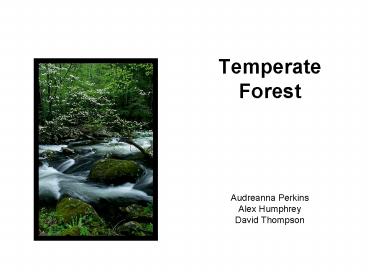Temperate Forest - PowerPoint PPT Presentation
1 / 8
Title:
Temperate Forest
Description:
http://www.taresearch.com/images/survey-research-pandas3.jpg. Unique characteristics ... meters of wood each year, about one third of the total amount logged in ... – PowerPoint PPT presentation
Number of Views:72
Avg rating:3.0/5.0
Title: Temperate Forest
1
Temperate Forest
Audreanna Perkins Alex Humphrey David Thompson
2
Characteristics
A temperate forest can be divided up into three
different layers Canopy the highest level.
This is the tree top layer The Understory made
up of saplings and shrubs. The forest floor
made up of small plants and saplings
Where are they found? Temperate forests grow
between the tropics and the polar regions in both
the Northern and Southern Hemispheres. In the
United States, temperate forests are widespread.
They are common in the Eastern side of the
country, from Maine to Florida.
3
(No Transcript)
4
Climate
-Deciduous forests have four definite
seasons. -During winter forests reach
temperatures close to 0 and receive around 18
inches of rain. -During summer forests reach
temperatures close to 70 and receive around 16
inches of rain.
Animals
Many of the animal species that we know are found
in temperate forests, They include insects
(ants, bees, beetles, etc), Birds (hawks, owls,
cardinals), and mammals (bears, wolves, deer).
Many animals are hard to see because they have
adapted camouflage. Some are nocturnal.
5
Plant Life of Temperate Forests Wide variety due
to abundant rainfall and thick humus
soil Vegetation exists in several layers
lichens and mosses ferns and shrubs on the
ground layer large tree species like oak
and hickory grow above the forest floor. Trees
in temperate forests can be classified into three
main types Deciduous lose their leaves when the
weather turns cold Ex maple, chestnuts, and
beech trees. Coniferous trees with seeds that
develop into cones Ex Pines, firs, and
cedars Broad-leaved Evergreens flat, leathery
leaves that are not lost in winter Ex Olive,
holly, and eucalyptus trees
6
Human Impacts
- -Early settlers cut down for fire wood,
construction material and farmland. - -After industrial revolution more wool was needed
so more grazing land was created (making barren
lands), herders also built stone walls in the
eastern part of America which still stand to this
day - -Acid rain caused by industrial and vehicle
emissions damages the leaves of trees, and causes
them to produce smaller and fewer seeds. It also
reduces the trees' resistance to disease, pests,
and frost. - air pollution contributes to acid
rain which destroys trees slowly by making them
more susceptible disease - - Air pollution also causes global warming and
some deciduous trees cannot survive at certain
temperature.
7
Endangered species
- Giant Pandas live in isolated temperate forests
located in mostly south-central China. - People and these peaceful creatures have been
able to live together for thousands of years but
Chinas population has been growing (now largest
in world) and the Pandas natural habitat has been
destroyed. Many pandas have been pushed into
small random pieces of what is left of the forest
and as a result they are not able to move though
out the land and reproduce the way they need.
http//www.taresearch.com/images/survey-research-p
andas3.jpg
8
Unique characteristics
- Walnuts, apples, mushrooms, and maple sugar are
all foods of the temperate forest.
- Logging in temperate forests yields around 1.25
billion cubic meters of wood each year, about one
third of the total amount logged in the whole
world.
9
References
- Human Impact
- http//videos.howstuffworks.com/hsw/17383-temperat
e-deciduous-forests-human-impact-video.htm - Landscape
- quest.arc.nasa.gov/projects/jason/xv/docs/TempRain
.doc - Climate
- http//www.blueplanetbiomes.org/deciduous_climate_
page.htm - http//oncampus.richmond.edu/academics/education/p
rojects/webunits/biomes/tforest.html - http//www.runet.edu/swoodwar/CLASSES/GEOG235/bio
mes/tbdf/tbdf.html - http//www.ucmp.berkeley.edu/exhibits/biomes/fores
ts.php - Endangered Species
- http//www.panda.org/index.cfm
- Other
- http//www.fauna-flora.org/temperateforests.php

